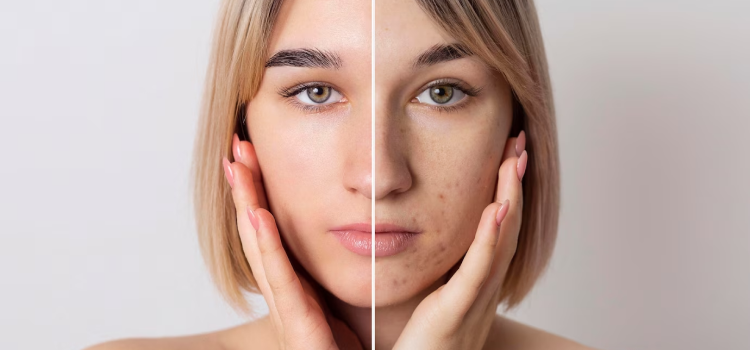
It occurs due to excessive exposure to sunlight without any protection. It generally involved entire face. Skin tone become one or two shade darker.
It generally seen as butterfly shape pigmentation over bridge of the nose and cheeks. Sometimes it may be seen over other areas like chin and forehead. The causes are variable like hereditary, hormonal changes, stress. Sunlight exposure can worsen it further. Treatment options are limited.
This type of pigmentation generally involves upper half of the face, mainly forehead. It can occurs secondary to family history, hormonal imbalances, chemicals, irritants and friction. Sunlight can worsen pigmentation further.
Many a times pimples, especially red and pus filled can leads to the pigmentation, if timely treatment not sought. Popping or picking at your pimples can also leads to stubborn marks.
This develops secondary to long term sunlight exposure. Usually seen as light or dark brown, round to oval flat spots. Seen over sun-exposed areas of the body like face, backs of the hands, neck, shoulder, back.
This are light brown to dark brown flat over to round spots generally seen over nose and cheeks. They are secondary to sun-exposure and more common in fair skin tones. They become more pronounce during summer and fade out during winter and rainy season. Their rapid occurrence can be a sign of internal diseases.
There are many clinical conditions associated with darkening of the skin like drug reactions, allergies, chemicals, lichen planus pigmentosus, Riehl’s melanosis, Erythema dischromicum perstans, poikiloderma of civatte. Do not neglect your pigmentation and sought medical help as soon as possible.
Is at most important, for any pigmentation to treat. Sun-light worsen existing pigmentation. A broad spectrum sunscreen with protection against UVA, UVB, infra red and visible light is important. Once a day application of sunscreen does not suffix. Reapplication of sunscreen every 3-4hourly is important.
Topical depigmenting creams and serums can be used to light pigmentation at night routine. They are also helpful for maintenance.
A selective chemical agent, as per your skin type and depth of pigmentation is applied on pigmented areas for stipulated time. It fade out pigmentation gradually, layer by layer. For spots, spot application is preferred. Multiple sessions spaces at adequate interval depending on type of agent used, skin type and season is required.
Pigmentary laser works by breaking pigmentation into small particles which then removed by body’s lymphatic system. They have specific wavelength, which specifically targets only pigmentation. Laser is safe and effective treatment. There is no long term side effects of laser.
If you have questions in regards to any, please feel free to ask us.